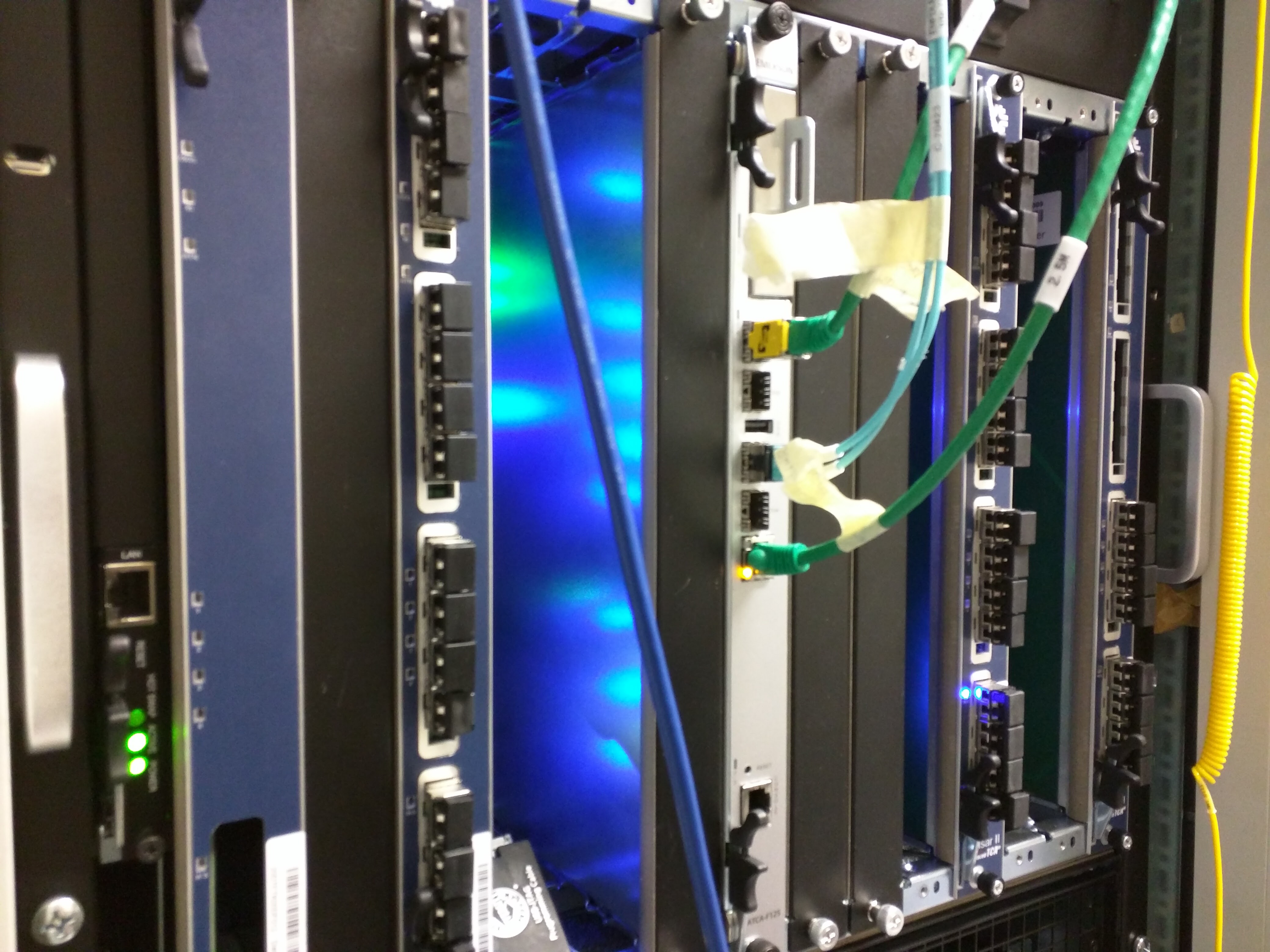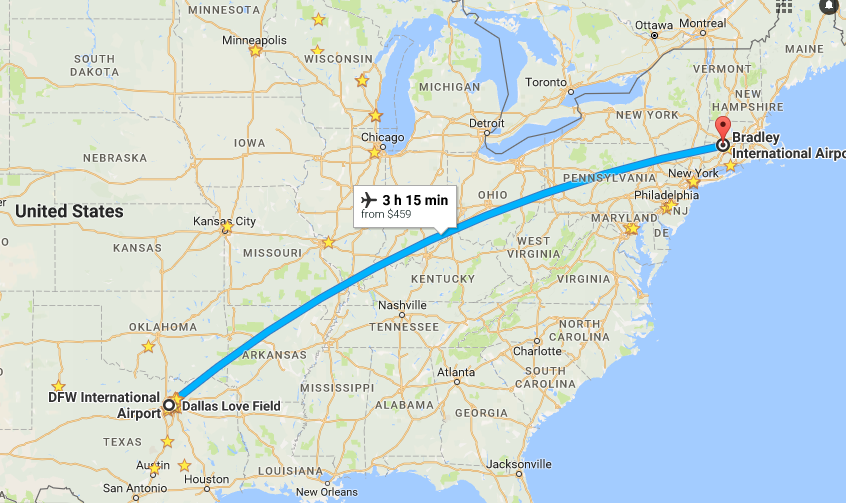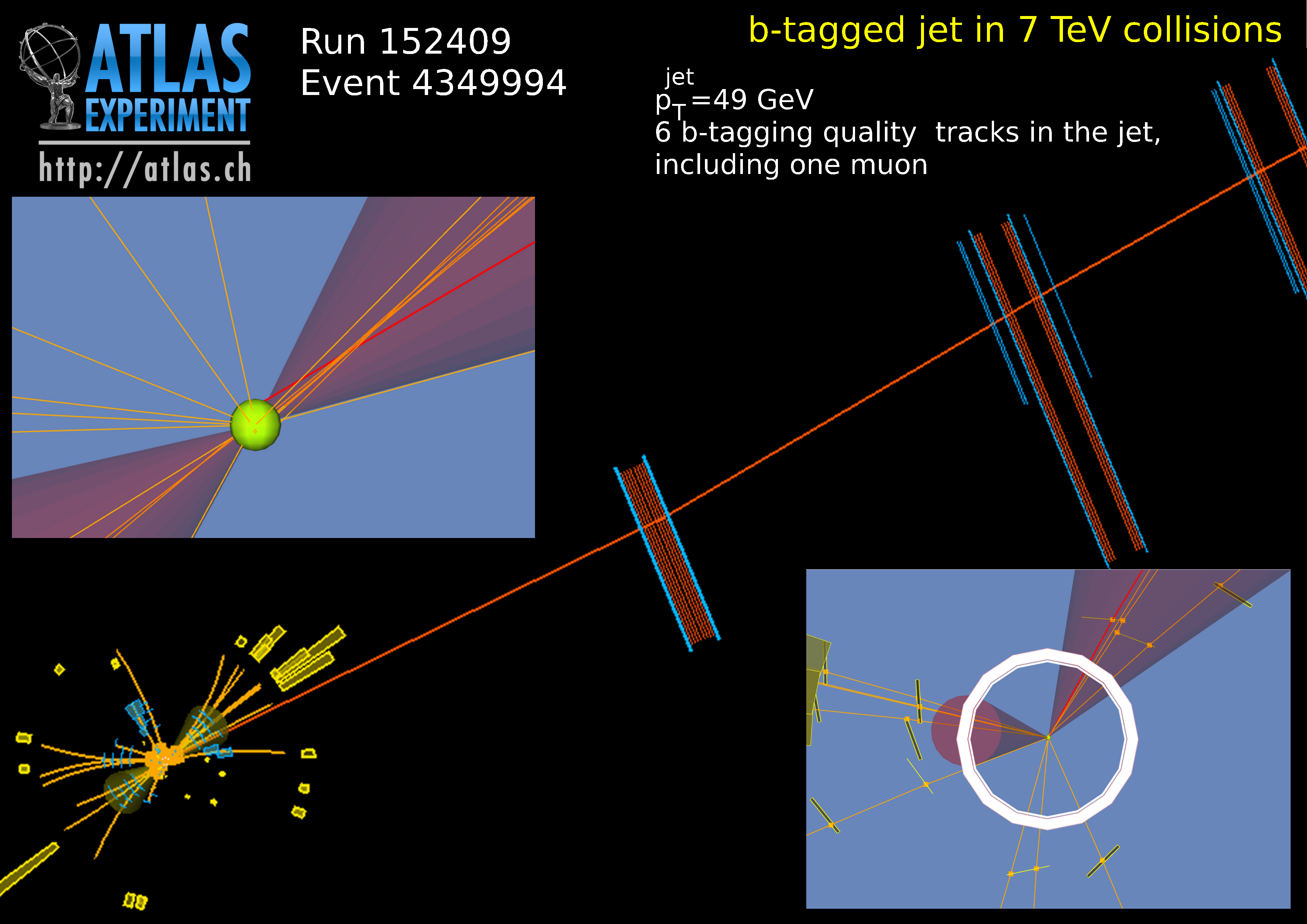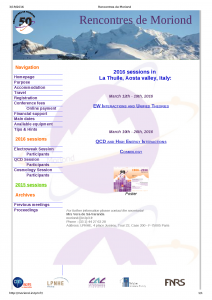
This last week was a killer. I’m lucky I didn’t get sick again. Up at 05:30 every day. In bed well after 21:00 or 22:00 every night but Friday night. There was an ATLAS conference note on the search for additional Higgs bosons to make public. There was an exam to write. There were SMU Scholar Candidates to interview and meet. There were a dozen tiny meetings, none of which had anything to do with anything else. And Jodi was traveling, which made commuting to and from SMU a frustrating strategic exercise. What a week.
Oh, and coda: Asus Chromebook C300 + Crouton = Tuxbook/Wildebook = Happy Steve.
Sending Physics Results to the Moriond ElectroWeak Conference
This week marked the start of the Moriond Conferences [1]. These are one of two major sets of international conferences for my field, particle physics. That makes them a prime target for hot new results from experiments like those at the LHC or other collider facilities across the globe, as well as the latest theoretical physics work on these subjects. Indeed, if you look at the agenda of this weeks “Moriond ElectroWeak” conference, you’ll see a tight interweaving of experimental and theoretical work. Into this fray, two large projects to which SMU makes significant contributions – the search for two-Higgs production and the search for a new Higgs boson, denoted A, decaying to a Z boson and a 125 GeV Higgs boson, h – were made public for the first time on the 2015 LHC data.
The search for the production of two Higgs bosons is, in part, a search for events that can tell us about the Higgs boson couples to itself, as opposed to how it couples to other particles (such as Z bosons). This is illustrated in the Feynman Diagram below.
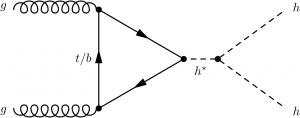
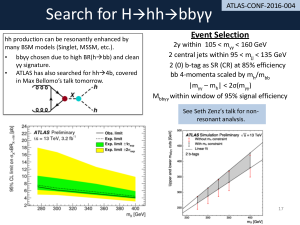
This is NOT the only process that contributes to the production of two Higgs bosons at a proton-proton collider, but finding these events will be the first step to disentangling this most interesting production mechanism from the competing ones. However, the real challenge here is that the Standard Model of Particle Physics makes a very definite prediction about the rate at which we should see these events . . . and it’s low. It’s not so low that it’s implausible that we might discover it, but it’s low enough that it means we have to be creative. SMU has been contributing to the search for ![]() , which balances the low-rate, high-resolution two-photon decay mode with the high-rate, low-resolution two-b-quark decay mode. Right now, most of the effort is concentrated on searching not for Standard Model production, which is believed to be out-of-reach for the time being, but on the possibility that new states of matter are FIRST produced in the collider, decay to HH, and then yield this interesting final state in the detector. So far, using just the 2015 data, there is no evidence of such production.
, which balances the low-rate, high-resolution two-photon decay mode with the high-rate, low-resolution two-b-quark decay mode. Right now, most of the effort is concentrated on searching not for Standard Model production, which is believed to be out-of-reach for the time being, but on the possibility that new states of matter are FIRST produced in the collider, decay to HH, and then yield this interesting final state in the detector. So far, using just the 2015 data, there is no evidence of such production.
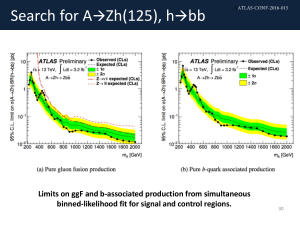
Where I have been far more involved has been in the search for ![]() , which has not yet been observed but which is (ironically) the largest single decay mode of the Standard Model Higgs boson. It’s a challenging mode because the two-b-quark final state is low-resolution compared to discovery channels like
, which has not yet been observed but which is (ironically) the largest single decay mode of the Standard Model Higgs boson. It’s a challenging mode because the two-b-quark final state is low-resolution compared to discovery channels like ![]() or the “golden mode,”
or the “golden mode,” ![]() . Right now, we don’t believe we have enough day to reliably measure the Standard Model process, but we can use it to search for additional cousins of the Higgs boson, such as a “CP-odd” cousin known as the A boson. The A is expected to have a decay channel like
. Right now, we don’t believe we have enough day to reliably measure the Standard Model process, but we can use it to search for additional cousins of the Higgs boson, such as a “CP-odd” cousin known as the A boson. The A is expected to have a decay channel like ![]() , and then we can look for known decays of the Z boson and the expected
, and then we can look for known decays of the Z boson and the expected ![]() decay of the 125 GeV Higgs boson.
decay of the 125 GeV Higgs boson.
These results were presented at Moriond this week by my colleague, Allison McCarn. Her slides are available online [3]. While we didn’t find evidence for these processes, going through the long and complex exercise of having dozens of people contribute dozens of ideas and tasks to developing this analysis, then working through the peer interaction process to solidify these ideas into an analysis that is then written up and presented at a conference, was excellent dress rehearsal for the bigger data sample we will collect in 2016 starting very, very soon.
The conference documents, which describe the analyses in detail, will appear on the web soon [4].
Exam 2: The Returnening
Monday and Tuesday were long days because I was working hard with my co-editor in Europe and the co-leaders of our ATLAS working group to make the conference note public in time for a CERN seminar on Tuesday and the Moriond Conference presentation by Allison on Wednesday. I thought I might be able to break the cycle of waking at 05:00 or 05:30 every day once that was done . . . but I was wrong. Since Jodi was traveling this week, I was commuting alone. When one commutes alone in the Dallas/Fort Worth Metroplex, one cannot expect to drive anywhere during rush hour and actually arrive in reasonable time. So, my strategy is to commute at unreasonable hours – very early or very late in the morning. However, my schedule of commitments this week barred me from commuting in the late morning, so early morning it was. But, then, inevitably there was unfinished work in the evening that took hours to complete. On Monday and Tuesday it was the paper; on Wednesday is was the writing of my second exam for PHYS 1308 (introductory electricity and magnetism for the life sciences majors).
I write my exams so late because I believe it’s bad to offer help to students AHEAD of the exam when you know what’s on the exam. Subtle biases in my response to student questions might tip the hand of what is or is not on the exam. So I surprise myself and them by writing it last-minute. It took me about an hour to write the exam on Wednesday evening and another hour or two to check the exam and then to write the solutions. I went to bed quite late, and awoke at 05:30 on Thursday morning. I wrote the grading rubric while eating breakfast near the SMU campus and then started in on photocopying when I got to SMU.
Well… sort of. My laptop has been unable to connect to SMU’s wifi network ever since they dumbed down the “eduroam” network at SMU. I can no longer use “eduroam” – which I prefer to use – to print or access email via IMAP because of all their irritating port-blocking and subnet blocking. So I was forced to switch to “PerunaNet,” the standard internal wifi network. But . . . wpa_supplicant, the GNU/Linux program for authenticating with a wifi network, refused to authenticate me to PerunaNet. So, I was unable to connect to PerunaNet and thus was unable to print my exam.
My solution: plug into ethernet at SMU. But that means I have to leave my laptop in my office and to learn that the printing failed, I have to then walk to the other end of the building, up one floor, get angry, and then return to my office. So I used OwnCloud to sync my exam to my desktop PC. However, this was a bust, too. I logged into my desktop linux PC only to find out the main disk was full and OwnCloud was unable to sync. That turned out to be a problem with a data backup script that was writing to the wrong partition, but I didn’t figure that out until Friday. Anyway, I was frustrated. I couldn’t print from my desktop, because the exam wasn’t synced to it; I couldn’t print from my laptop, because of the wifi problems.
I managed to cut a path through these problems and finally printed my exam. Photocopying it takes another 45 minutes – the exam has three parts, 55 copies each (for 55 students). Then there are rubrics, and then solutions, etc. That is a lot of waiting.
The exam itself seemed to go well, but by the end of Thursday I was wiped out. Jodi’s flight landed at 7:45pm, and finally we could have our lives return to something resembling sanity… except that I had to be into SMU by 8am on Friday for the start of the Scholar Candidate Interview Day at SMU. So there was one more day left…
Scholar Candidate Interview Day at SMU
Friday was the day when the best of the best students in our incoming undergraduate candidate group comes to campus for final interviews for merit and leadership scholarships. The President’s Scholar Candidates and the Hunt Leadership Scholar Candidates were everywhere on Thursday, visiting classes and touring SMU with current scholars. But Friday was the day of interviews, where teams of students, faculty, and former scholars conduct 25-minute interviews to identify those students who are just the absolute best of the best for these programs. It’s a tough process for the students and the interviewers; the students are under tremendous pressure to distinguish themselves in person, and the interviewers are under tremendous pressure to ask the right questions to get to the heart of these students’ motivations, accomplishments, and visions for their futures.
By noon, the end of the Hunt Scholar Interview period, we on the interview teams were all wiped out. But, my reward what that I had lunch with some of the Presidents and Hunts Scholar Candidates for programs in Dedman College. That was AMAZING. I love meeting these scholar candidates and their parents. They are so motivated, so driven, so focused. I wish I had been like that when I was in high school. I thought I was smart when I went to college. Then I got beat up academically. I learned what it means to compete against and with the best of the best. Eventually, I learned how to handle that. But these students already have those skills. I suspect that if I had to compete against these students, knowing only what I knew when I was a senior in high school, and being only who I was as a senior in high school, that they would wipe the floor with me.
And that makes me proud. Faculty at other schools often lament that “this is the worst group of students I have ever seen,” and they say that every year, or every 5 years, or every ten years. But I am proud to say that every year at SMU, I am forced to admit that “this is the best group of students I have ever seen.” That won’t continue forever, but I am proud to be at an institution not only where I get to say it now… but that when I say it I am talking about students who could easily compete with their counterparts at high-pedigree schools on the East and West coasts, and who will eventually go onto to graduate or medical or law programs at those institutions, because they are just objectively outstanding scholars. That is a great feeling.
And it carried me through one more day of early-to-rise…
Weekend
Made it. Now it’s the weekend. Now I will recover from this week. And then I will do it again next week. Because being a faculty member is awesome.
Coda: Tuxbook/Wildebook
In some of my limited free time, I distracted myself from stress this week by learning about Crouton [5], a set of tools for installing GNU/Linux on a Chromebook. ChomeOS, the Chromebook operating system, is based on Linux… it’s just not GNU/Linux. It’s locked down. I also really missed LibreOffice, for instance. There are just NO viable LibreOffice choices on ChromeOS.
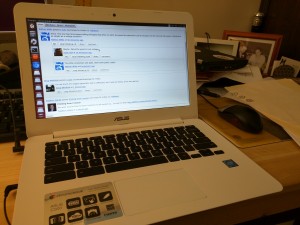
Good news is that it doesn’t matter. Crouton installs the binaries for a minimal GNU/Linux system (e.g. Ubuntu 14.04) in a chrooted environment in ChromeOS, then fires up an X-server and runs the linux desktop alongside ChromeOS. It’s not dual-booting – it’s co-living. Switching between the ChromeOS and Ubuntu desktop is as simple as a keystroke. I love it.
I ordered a 64GB, class-10 SD card to augment storage on the Chromebook. And, two graduate students came up with a new name for this kind of Chromebook:
- Matthew, more aligned with the side of the community who supports the use of “Linux” as the singular descriptive term with “Tux” as its mascot, called it a “Tuxbook”
- Eric, more aligned with the GNU side of the community and its mascot, the gnu (which is really a variety of wildebeest), suggested “Wildebook”
I will let you decide. I like either. What I like most is a real OS on a cheap, $200, well-constructed Chromebook.
[1] https://indico.in2p3.fr/event/12279/other-view?view=standard
[2] https://atlas.web.cern.ch/Atlas/GROUPS/PHYSICS/PAPERS/HIGG-2013-33/
[3] https://indico.in2p3.fr/event/12279/session/12/contribution/168/material/slides/0.pdf
[4] https://twiki.cern.ch/twiki/bin/view/AtlasPublic/Winter2016-13TeV

